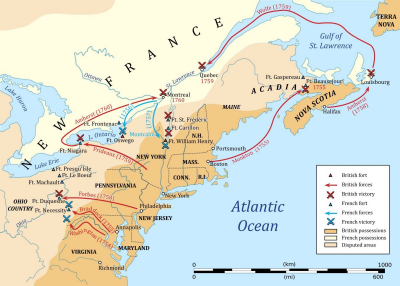The Battle of Lake George was fought on 8 September 1755, in the north of the Province of New York. It was part of a campaign by the British to expel the French from North America, in the French and Indian War.On one side were 1,500 French, Canadian, and Indian troops under the command of the Baron de Dieskau. On the other side were 1,500 colonial troops under William Johnson and 200 Mohawks led by noted war chief Hendrick Theyanoguin. The battle consisted of three separate phases and ended in victory for the British and their allies. After the battle, Johnson decided to build Fort William Henry in order to consolidate his gains.
The French and Indian War (1754–1763) was a theater of the Seven Years' War, which pitted the North American colonies of the British Empire against those of the French, each side being supported by various Native American tribes. At the start of the war, the French colonies had a population of roughly 60,000 settlers, compared with 2 million in the British colonies. The outnumbered French particularly depended on the natives.Two years into the French and Indian War, in 1756, Great Britain declared war on France, beginning the worldwide Seven Years' War. Many view the French and Indian War as being merely the American theater of this conflict; however, in the United States the French and Indian War is viewed as a singular conflict which was not associated with any European war. French Canadians call it Guerre de la Conquête ('War of the Conquest').The British colonists were supported at various times by the Iroquois, Catawba, and Cherokee tribes, and the French colonists were supported by Wabanaki Confederacy member tribes Abenaki and Mi'kmaq, and the Algonquin, Lenape, Ojibwa, Ottawa, Shawnee, and Wyandot tribes. Fighting took place primarily along the frontiers between New France and the British colonies, from the Province of Virginia in the south to Newfoundland in the north. It began with a dispute over control of the confluence of the Allegheny River and Monongahela River called the Forks of the Ohio, and the site of the French Fort Duquesne at the location that later became Pittsburgh, Pennsylvania. The dispute erupted into violence in the Battle of Jumonville Glen in May 1754, during which Virginia militiamen under the command of 22-year-old George Washington ambushed a French patrol.In 1755, six colonial governors met with General Edward Braddock, the newly arrived British Army commander, and planned a four-way attack on the French. None succeeded, and the main effort by Braddock proved a disaster; he lost the Battle of the Monongahela on July 9, 1755, and died a few days later. British operations failed in the frontier areas of the Province of Pennsylvania and the Province of New York during 1755–57 due to a combination of poor management, internal divisions, effective Canadian scouts, French regular forces, and Native warrior allies. In 1755, the British captured Fort Beauséjour on the border separating Nova Scotia from Acadia, and they ordered the expulsion of the Acadians (1755–64) soon afterwards. Orders for the deportation were given by Commander-in-Chief William Shirley without direction from Great Britain. The Acadians were expelled, both those captured in arms and those who had sworn the loyalty oath to the King. Natives likewise were driven off the land to make way for settlers from New England.The British colonial government fell in the region of Nova Scotia after several disastrous campaigns in 1757, including a failed expedition against Louisbourg and the Siege of Fort William Henry; this last was followed by the Natives torturing and massacring their colonial victims. William Pitt came to power and significantly increased British military resources in the colonies at a time when France was unwilling to risk large convoys to aid the limited forces that they had in New France, preferring to concentrate their forces against Prussia and its allies who were now engaged in the Seven Years' War in Europe. The conflict in Ohio ended in 1758 with the British–American victory in the Ohio Country. Between 1758 and 1760, the British military launched a campaign to capture French Canada. They succeeded in capturing territory in surrounding colonies and ultimately the city of Quebec (1759). The following year the British were victorious in the Montreal Campaign in which the French ceded Canada in accordance with the Treaty of Paris (1763).
France also ceded its territory east of the Mississippi to Great Britain, as well as French Louisiana west of the Mississippi River to its ally Spain in compensation for Spain's loss to Britain of Spanish Florida. (Spain had ceded Florida to Britain in exchange for the return of Havana, Cuba.) France's colonial presence north of the Caribbean was reduced to the islands of Saint Pierre and Miquelon, confirming Great Britain's position as the dominant colonial power in northern America.

1755Sep, 8
French and Indian War: Battle of Lake George.
Choose Another Date
Events on 1755
- 15Apr
A Dictionary of the English Language
Samuel Johnson's A Dictionary of the English Language is published in London. - 9Jul
Battle of the Monongahela
The Braddock Expedition is soundly defeated by a smaller French and Native American force in its attempt to capture Fort Duquesne in what is now downtown Pittsburgh. - 25Jul
Expulsion of the Acadians
British governor Charles Lawrence and the Nova Scotia Council order the deportation of the Acadians. - 10Aug
Expulsion of the Acadians
Under the orders of Charles Lawrence, the British Army begins to forcibly deport the Acadians from Nova Scotia to the Thirteen Colonies. - 1Nov
1755 Lisbon earthquake
In Portugal, Lisbon is totally devastated by a massive earthquake and tsunami, killing between 60,000 and 90,000 people.

 English
English  español
español  français
français  português
português  русский
русский  العربية
العربية  简体中文
简体中文 